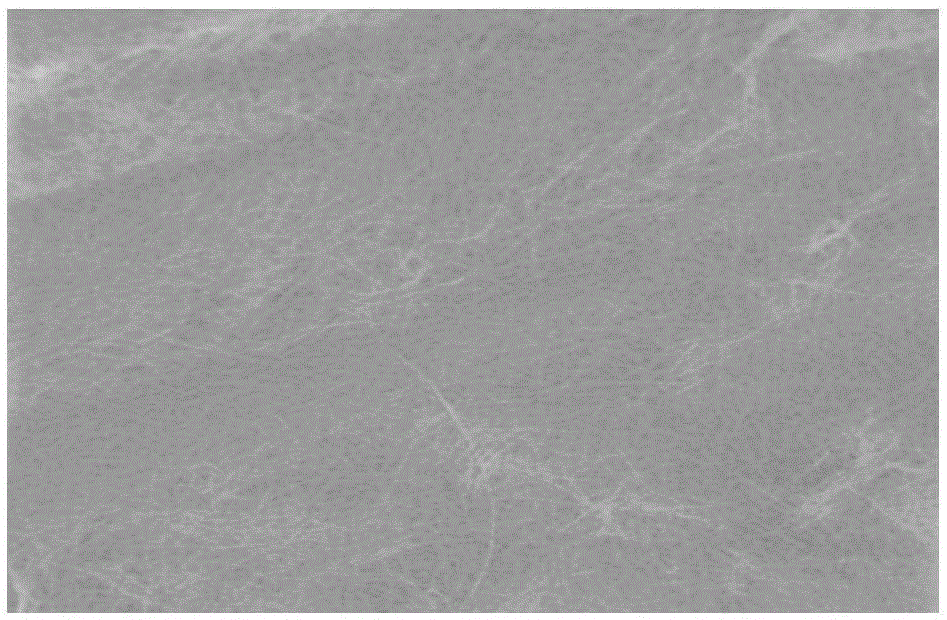Making method for molybdenum oxide nano-fiber paper hydrogen sensor
A technology of nanofiber and molybdenum oxide, applied in the direction of material resistance, etc., to achieve high specific surface area, good recovery performance, and good repeatability
- Summary
- Abstract
- Description
- Claims
- Application Information
AI Technical Summary
Problems solved by technology
Method used
Image
Examples
preparation example Construction
[0027] A method for preparing a molybdenum oxide nanofiber paper hydrogen sensor of the present invention is to sputter a metal Pt / Pd nanoparticle array on a molybdenum oxide nanofiber paper covered with a metal mask to form a conductive electrode method; the preparation method includes the following steps: step:
[0028] (1) Take the molybdenum oxide nanofiber paper of the set size;
[0029] (2) Select a sputtering metal mask with a set size, and there are 12 pairs of interdigitated electrodes on the metal mask, and cover the metal mask on the molybdenum oxide nanofiber paper to form a substrate;
[0030] (3) metal Pt / Pd nanoparticle arrays are sputtered on the substrate to make a hydrogen sensor with conductive electrodes:
[0031] (4) After the sputtering is completed, the metal mask is removed, and the molybdenum oxide nanofiber paper after the sputtered Pt / Pd nanoparticle array is cut from the middle along the length direction to become two hydrogen sensitive elements wi...
Embodiment 1
[0035] 1. Select molybdenum oxide nanofiber paper with a size of 30mm×20mm.
[0036] 2. Select a metal mask with the same size as the molybdenum oxide nanofiber paper (such as figure 2 As shown), the metal mask plate has 4 large electrodes and 12 pairs of small electrodes. Adopting this structure is beneficial to subsequent testing and packaging.
[0037] 3. Cleaning of the mask: The selected metal mask is ultrasonically cleaned for 30 minutes with analytical acetone, pure ethanol and deionized water, and then baked in air at a temperature of 60°C for 20 minutes to obtain a clean and dry mask. Metal mask.
[0038] In this embodiment, the ultrasonic cleaner is a commercially available numerically controlled ultrasonic cleaner with a cleaning power of 40-100W.
[0039] 4. Using standard DC magnetron sputtering technology to prepare oxide film nanofiber paper hydrogen sensor, the steps are as follows:
[0040] (1) Place the sample: First, open the magnetron sputtering equipme...
Embodiment 2
[0048] 1. Select molybdenum oxide nanofiber paper with a size of 30mm×20mm.
[0049] 2. Select a metal mask with the same size as the molybdenum oxide nanofiber paper (such as figure 2 As shown), the metal mask plate has 4 large electrodes and 12 pairs of small electrodes. Adopting this structure is beneficial to subsequent testing and packaging.
[0050] 3. Cleaning of the mask: The selected metal mask is ultrasonically cleaned for 30 minutes with analytical acetone, pure ethanol and deionized water, and then baked in air at a temperature of 60°C for 20 minutes to obtain a clean and dry mask. Metal mask.
[0051] In this embodiment, the ultrasonic cleaner is a commercially available numerically controlled ultrasonic cleaner with a cleaning power of 40-100W.
[0052] 4. Using standard DC magnetron sputtering technology to prepare oxide film nanofiber paper hydrogen sensor, the steps are as follows:
[0053] (1) Place the sample: First, open the magnetron sputtering equipme...
PUM
 Login to View More
Login to View More Abstract
Description
Claims
Application Information
 Login to View More
Login to View More - R&D
- Intellectual Property
- Life Sciences
- Materials
- Tech Scout
- Unparalleled Data Quality
- Higher Quality Content
- 60% Fewer Hallucinations
Browse by: Latest US Patents, China's latest patents, Technical Efficacy Thesaurus, Application Domain, Technology Topic, Popular Technical Reports.
© 2025 PatSnap. All rights reserved.Legal|Privacy policy|Modern Slavery Act Transparency Statement|Sitemap|About US| Contact US: help@patsnap.com



